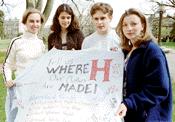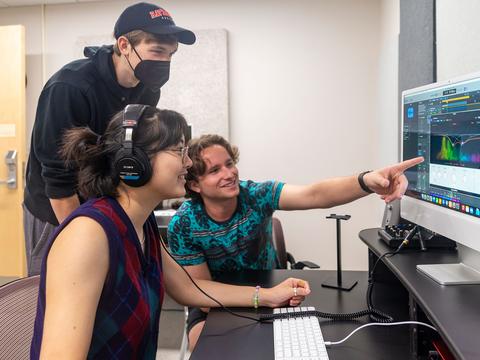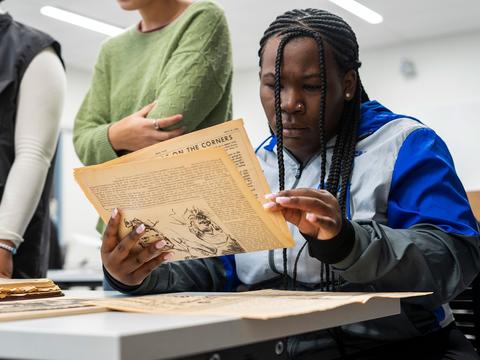Haverford Students Take Action

(left to right) Sara Wolf '03, Kate Conway '02, Ben Stokes '00 and Christine Farrenkopf '02.
Details
Fourth-year student Maria Roeper witnessed all of this during a trip to Jakarta, Indonesia, and she returned to Haverford determined to make changes to the working conditions in the clothing manufacturing industry.
Roeper became a national leader in the anti-sweatshop movement, joining organizations like United Students Against Sweatshops--comprised of numerous students at more than 150 colleges and universities in North America, attending protests and rallies throughout the country and encouraging other college students to join the fight against sweatshop labor.
With her guidance, a number of Haverford students have rallied against the abuses of the clothing manufacturing industry, forming a group known as Haverford Students Against Sweatshops. The group has become a local force and national presence in the anti-sweatshop movement.
"We have a responsibility as individuals and as part of the Haverford community, to educate others," says Sara Wolf, an anti-sweatshop supporter. "As students, we have the time, resources and power to do that."
Haverford Students Against Sweatshops has formed alliances with students from other local colleges and universities and drafted a resolution that was presented to Philadelphia's City Council in December. By unanimously approving the resolution, members of City Council agreed to send letters to all local college and university administrators, urging them to actively oppose sweatshop labor by joining the Worker Rights Consortium (WRC).
The Worker Rights Consortium is a non-profit organization that has created a "sweatshop-free" code of conduct that includes provisions for increased wages, disclosure of factory locations and independent monitoring of factory conditions. Colleges and universities that join the Worker Rights Consortium pledge to purchase apparel only from companies that meet the WRC's anti-sweatshop labor standards.
The influence of Roeper and Haverford Students Against Sweatshops led Haverford College to become one of the first institutions to join the Worker Rights Consortium.
Over the past months anti-sweatshop protests and rallies occurred at many colleges and universities, including Michigan, Wisconsin, Tulane, Oregon, Georgetown and Pennsylvania. As a result, the Worker Rights Consortium now consists of 48 members.
The anti-sweatshop protests appear to be working. The New York Times reports that, according to some monitoring groups, pressure from college students has led some factories to cut back on child labor and require fewer employees to work 80-hour weeks.
Although Roeper led the way, many other Haverford students played important roles in anti-sweatshop activities. Adam Berg'03 participated in the protest of the World Trade Organization in Seattle, while Ben Stokes'00 took part in various sit-ins. "Our courses often emphasize national and global perspectives, so our students are more aware of issues that affect others," says Stokes. Christine Farrenkopf'02 and Wolf'03 attended a rally outside of Philadelphia's City Hall, and Berg traveled to New York City for the Worker Rights Consortium's founding conference in April.
"Haverford has always been an institution that educates the whole person," says Wolf. "Our actions show that students are interested in issues that exist outside of their academic sphere."
Recent activism on the part of Haverford students hasn't been confined to the anti-sweatshop movement. The women's tennis team canceled its spring break matches on Hilton Head Island to support the NAACP's tourism boycott against South Carolina, an attempt to force the state to remove the Confederate flag from its Capitol in Columbia.
After watching Martin Luther King, Jr. Day protests of theConfederate flag on television, women's tennis head coach Ann Koger decided to call off the trip to South Carolina.
"I didn't want to take the students and their parents into a potentially uncomfortable and unsafe situation," says Koger of the decision.
Haverford's director of athletics, Greg Kannerstein, supported Koger's desire to change the team's plans, saying that "training in South Carolina would be a violation of Haverford's long tradition of respect for all individuals. The college does not want to contribute to the tourist economy of a state which shows disrespect to a large segment of its citizens."
Instead of playing matches on Hilton Head, as the women's tennis team had done since 1988, Koger took her players to Grenelefe, Florida for spring break competitions as well as a training session at the world-famous Bollettieri Sports Academy in Bradenton.
"Going to Florida instead of Hilton Head wasn't so much a sacrifice as it was a way of alerting other people to the flag situation and forcing them to think about their actions," explains Alyssa Kennedy'02, who won the Centennial Conference singles title this spring.
In fact, some local colleges, including Bryn Mawr, Dickinson, Franklin and Marshall, Swarthmore and Temple, subsequently joined the boycott as well.
According to news reports, the New York Knicks also canceled plans to conduct its playoff training camp in Charleston; professional women's tennis star Serena Williams backed out of a tournament on Hilton Head; and a few collegiate athletic conferences decided to move their post-season tournaments out of South Carolina.
"I hope that others followed our lead for the right reasons, based on their values and principles," says Koger. "This issue affects all people because it involves our national conscience."
The women's tennis players embraced their coach's decision, registering their opposition to the Confederate flag issue. "It's a credit to the students' upbringing and independence of thought," says Koger of her players' support and other activism on campus.
"We wanted our coach to know that we were behind her," says Kaley Klanica'00. "The boycott was a perfect way for all of us to show how powerful a peaceful protest can be."
The tennis team's boycott was reported by a number of newspapers throughout the country as well as by ESPN. As a result, the actions of a few "Fords" became known by many.
Reflecting on the small, liberal arts college's presence in national issues, Koger says, "Haverford was known in the 1960s as a very loud voice of social consciousness, and it's nice to know that the tradition still exists."



